Astronaut Mark Watney and RTG
In the just-released film The Martian ( trailer , book ). I was hooked on one plot twist. At some point, in order to go on a long trip to Mars on a rover, Mark solves the problem of heating at night (on Mars, the temperature can drop to -80 C at night). He decides to put it in his cockpit, something very similar to the radioisotope generator (!) (RTG) MMRTG , used in the Curiosity robot. In turn, MMRTG is almost half of the classic American GPHS-RTGs that were used on Galileo, Cassini, and New Horizons spacecraft to supply them with electricity far from the Sun. Today we will figure out how dangerous it is to put a radioisotope generator in your rover.

As we can see in the picture above, the real RTGs that were supplied at Cassini are treated fairly carefully - dosimetry, shields that reduce the exposure of personnel in the room.
')
What is GPHS-RTG ? This is a modular RTG using the decay heat of 238 Pu to convert it into its electrical energy on a semiconductor thermoelectric converter. However, only the radiator is visible from the outside, which operates with the cold end of the converter.

In the center of this device are 18 square General Purpose Heat Sorces - general-purpose heat sources, actually containing plutonium. They in turn are arranged as follows:

2 tablets (Fuel pellet), the size of a large nut made of plutonium oxide (151 grams of oxide or ~ 116 grams of plutonium), coated with iridium (which we will discuss later) are placed in a cylindrical container made of carbon-carbon composite, which serves as a defense in case of a fall such an RTG in the elimination phase. Two such containers, in turn, are packaged in one prismatic block of graphite, which is one GHPS. The weight of one assembled unit is 1.43 kilograms, and with a fresh radionuclide it produces 250 watts of heat, heating up in the generator to 1000 C.

Assembled ghps
Considering an efficiency of about 6%, at the beginning of his life, GPHS-RTG produced about 300 electric watts dissipating ~ 4400 watts from a radiator. For MMRTG, these figures are 125 and 2000 watts. Fourteen years after the extraction of plutonium from the reactor, the power drops by about a quarter. The most interesting thing is that the power drops not only because of the natural decay of the isotope, but also because of the degradation of thermocouples. As a source of heat, this device is more attractive - 1.6% reduction in heat output per year.
Well, 2 kilowatts of heat looks encouraging for Mark Watney, now let's talk about the dangers.
238 Pu - A good choice for RTGs. It decays into 234 U with the emission of alpha particles with an energy of ~ 5.5 MeV. Alpha particles are easily screened - all of them will slow down even in the iridium envelope of the fuel pellet (iridium is needed here, which would in any case, for example, when falling into the tundra, resist radiation corrosion). Unfortunately, there are three obstacles to the absolute non-radioactivity of our heat source:
All together, for GPHS-RTG, the radiation level (or, as it is more correctly called, the equivalent dose rate) is from 20 to 50 milli-raytens per hour in different directions at a distance of one meter. This level is composed of neutron and gamma radiation, and the share of the latter for real RTGs is not so large - 5 ... 10 mr / hour .
For MMRTG, which is used by Watney, the levels should be more than 2 times lower - about 8..20 mr / hour . Moreover, theoretically, the neutron part can be shielded with a centimeter or another polyethylene (better than the boronized one). Even in the most unfortunate scenario, at 20 mr / hour, a certain level that can affect health (100 roentgens) the Martian hero would gain 5000 hours, or about 202 sol (Martian days). Over the years, the gamma radiation from the RTG will increase and the neutron emission will fall, but these changes are noticeable over ten-year periods and do not greatly affect the overall level of radioactivity.

However, the simulation of the American nuclear industry GPHS-RTG shows that an RTG contact can give much more dangerous levels of 1 and even 5 X-rays / hour
Well, if you find yourself in a similar situation - boldly warm the salon of your rover with an RTG, just be sure to make sure it is filled with Pu238 and not with a malicious Sr90 betta emitter, as in domestic ground-based generators :).
PS By the way, the film is quite nothing, although for fans of the original, filled with a mass of technical details, the text of the level of popularization can be frustrating.

As we can see in the picture above, the real RTGs that were supplied at Cassini are treated fairly carefully - dosimetry, shields that reduce the exposure of personnel in the room.
')
What is GPHS-RTG ? This is a modular RTG using the decay heat of 238 Pu to convert it into its electrical energy on a semiconductor thermoelectric converter. However, only the radiator is visible from the outside, which operates with the cold end of the converter.

In the center of this device are 18 square General Purpose Heat Sorces - general-purpose heat sources, actually containing plutonium. They in turn are arranged as follows:

2 tablets (Fuel pellet), the size of a large nut made of plutonium oxide (151 grams of oxide or ~ 116 grams of plutonium), coated with iridium (which we will discuss later) are placed in a cylindrical container made of carbon-carbon composite, which serves as a defense in case of a fall such an RTG in the elimination phase. Two such containers, in turn, are packaged in one prismatic block of graphite, which is one GHPS. The weight of one assembled unit is 1.43 kilograms, and with a fresh radionuclide it produces 250 watts of heat, heating up in the generator to 1000 C.

Assembled ghps
Considering an efficiency of about 6%, at the beginning of his life, GPHS-RTG produced about 300 electric watts dissipating ~ 4400 watts from a radiator. For MMRTG, these figures are 125 and 2000 watts. Fourteen years after the extraction of plutonium from the reactor, the power drops by about a quarter. The most interesting thing is that the power drops not only because of the natural decay of the isotope, but also because of the degradation of thermocouples. As a source of heat, this device is more attractive - 1.6% reduction in heat output per year.
Well, 2 kilowatts of heat looks encouraging for Mark Watney, now let's talk about the dangers.
238 Pu - A good choice for RTGs. It decays into 234 U with the emission of alpha particles with an energy of ~ 5.5 MeV. Alpha particles are easily screened - all of them will slow down even in the iridium envelope of the fuel pellet (iridium is needed here, which would in any case, for example, when falling into the tundra, resist radiation corrosion). Unfortunately, there are three obstacles to the absolute non-radioactivity of our heat source:
- The main working isotope of plutonium decays in U234, which gives rise to a number of radioactive isotopes, among which are gamma emitters.
- Plutonium tablets contain other, not so friendly from the point of radioactive radiation, isotopes - 236 Pu, 239 Pu, 241 Pu and decay products, such as a hard gamma emitter 208 Ta. Unfortunately, the production process (by irradiating targets from another radioactive isotope - Neptunium 237 in the reactor) is always accompanied by the appearance of these parasitic isotopes. The best samples of 238 Pu contain about 17% of other isotopes.
- Finally, the most interesting. Energetic alpha particles of plutonium interact with oxygen (which is contained in plutonium oxide) and generate neutron radiation with it through nuclear reactions. A part of neutron radiation also comes from the spontaneous decay of plutonium (not alpha decay, but disintegration into 2 parts - like uranium in a nuclear chain reaction).
All together, for GPHS-RTG, the radiation level (or, as it is more correctly called, the equivalent dose rate) is from 20 to 50 milli-raytens per hour in different directions at a distance of one meter. This level is composed of neutron and gamma radiation, and the share of the latter for real RTGs is not so large - 5 ... 10 mr / hour .
For MMRTG, which is used by Watney, the levels should be more than 2 times lower - about 8..20 mr / hour . Moreover, theoretically, the neutron part can be shielded with a centimeter or another polyethylene (better than the boronized one). Even in the most unfortunate scenario, at 20 mr / hour, a certain level that can affect health (100 roentgens) the Martian hero would gain 5000 hours, or about 202 sol (Martian days). Over the years, the gamma radiation from the RTG will increase and the neutron emission will fall, but these changes are noticeable over ten-year periods and do not greatly affect the overall level of radioactivity.

However, the simulation of the American nuclear industry GPHS-RTG shows that an RTG contact can give much more dangerous levels of 1 and even 5 X-rays / hour
Well, if you find yourself in a similar situation - boldly warm the salon of your rover with an RTG, just be sure to make sure it is filled with Pu238 and not with a malicious Sr90 betta emitter, as in domestic ground-based generators :).
PS By the way, the film is quite nothing, although for fans of the original, filled with a mass of technical details, the text of the level of popularization can be frustrating.
Source: https://habr.com/ru/post/368603/
All Articles